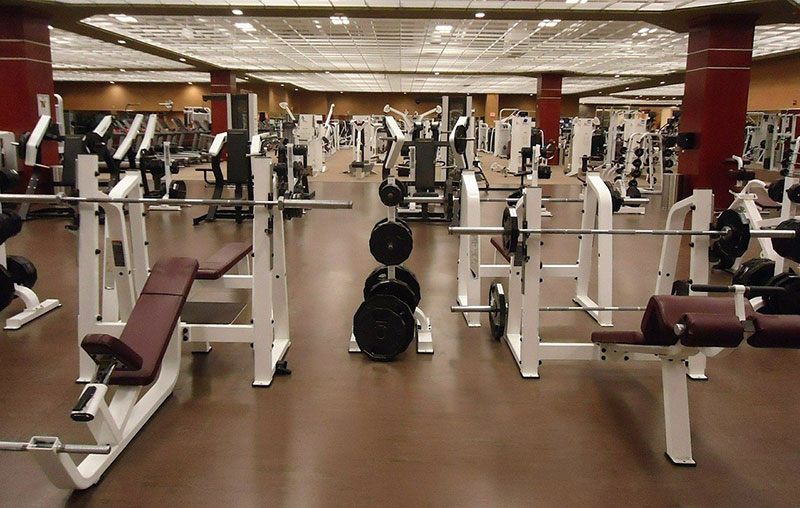Are you looking to turn your gym business dreams into reality but the question of “how much do gym owners make?” keeps popping up? Well, that’s a valid question. It’s completely normal to want to do something you can make a decent living out of. So, what’s a gym owner’s salary you can expect?
To answer this question fully, you must first understand all the factors that affect this magic number. In order to help you calculate it yourself, we prepared this rundown of all the necessary aspects determining the outcome.
We will cover everything from the average gym owner’s salary to the factors that impact it and how you can maximize your earning potential.
Are Gyms Even Profitable?
The fitness industry is growing like never before. Serious competition has made it more difficult than ever to turn a profit. But with gym profitability being undeniable, you just need a bit of help navigating this competitive landscape.
It’s obvious there is a huge potential in a wellness business. Yet 8 out of 10 gym businesses will fall short in their first year. So, how can you ensure your facility places in the remaining two?
As with most organizations, an exercise center has peak and respite periods. During the first year, owners see these become an important factor. They learn to leverage this seasonality to help them reach higher profits.
Generally speaking, the primary quarter of the year is the best time to acquire new members. This is due to the obvious factor of New Year’s resolutions.
The year starts with fresh goals to improve health and fitness. This proceeds through cold weather days and months when outside sport comes to a halt.
How Much Money Can Gym Owners Make?
As of May 7, 2024, ZipRecruiter reports that the normal compensation for a gym owner in the U.S. is $86,197 per year. This breaks down to $1,657/week or $7,138/month.
ZipRecruiter also indicates yearly salaries to be as high as $294,500 and as low as $21,500.
Currently, most gym owners’ salaries are between $26,500 (25th percentile) and $125,000 (75th percentile). Top workers (90th percentile) make $242,000 every year across the U.S.
As you can see, the salary of a gym owner differs by as much as $98,500. This is no doubt affected by many factors that we will mention in the continuation. The statistics also show tremendous potential for increased earnings.
Keep in mind that gym owner salaries will also vary from state to state and depending on locale.
Understand the Gym Profit Margin
When diving into this business venture, a natural question is, do gyms make money? While we can answer with a simple yes, our ultimate goal is to help you better understand how much do gyms make.
According to the research done by IHRSA back in 2017, the profit margin for fitness-only clubs was registered at about 20%. On the other hand, multipurpose clubs had a profit margin of 15.5%. And it seems that the numbers haven’t changed much since then.
Remember that your gym or fitness club’s profit margin will depend on factors such as location, facility size, type of gym, and various other aspects.
What Factors Determine How Much Money Gym Owners Make?
There is a wide range of factors that affect gym owner salaries. They range from the size and type of gym to the geographical location.
This is precisely why it’s so hard to give an exact answer to the question of how much gym owners make a month. With such a wide range of variables, it’s necessary to factor each one in.
These range from the size and type of gym to the geographical location.
In addition, many operational aspects will affect the gym business’ total revenue. Here is a list of factors and how to use them to your advantage:
1. The size of the gym

The biggest factor to consider is how many members the facility can accommodate. This affects the potential revenue a gym can generate. Therefore, it has a significant impact on a gym owner’s salary.
Some gyms operate in small spaces with less equipment. Their expected revenue is much less than that of gyms operating in larger facilities. Gyms with larger spaces can provide more equipment and services to their members. Too small of a space will surely not be able to attract as many members.
So be selective about the space leased or bought for a gym. Make sure that it will generate enough income and not be too expensive for the budget.
However, don’t get stuck with a space that is too large. This can lead to a lot of unused room that cost money but don’t generate income.
2. Gym Location
Location is an important factor that has a massive effect on gym owners’ salaries. This seems rather obvious as the cost of living also differs depending on the area. According to ZipRecruiter, in the state of California, gym owners make as much as $147,699 per year. This makes Berry Creek the highest-earning town, followed by Talmage with an annual salary of $139,204. Other notable states include Florida, with Palm Beach reporting a gym owner’s salary of $113,278. And DC, with Washington’s gym owners earning an annual salary of $106,565.
When you look at the bigger picture, taking into consideration the fact that some gym business owners make as little as $21,500, relocation may be the best option if you want to secure a higher income.
3. The business model of the gym
There is a wide variety of established gym business models to choose from. These vary in overhead costs and the average gym income they can potentially generate.
Some of the different models include and may combine:
- traditional health club style
- Crossfit style
- yoga studio
- aerobics studio
- cardio studio
- spin center
- weight lifting center
- aquatics center
A business model may include any of these options or hybrid combinations. Some gym owners also explore strategic alliances. For example, a CrossFit gym may obtain a discount for their members at a local aquatics center and vice versa. These types of collaborations can improve revenues and drive memberships.
3. Start-up cost
The start-up cost has a big impact on any business. A small CrossFit-style gym may start as low as $10,000. A larger facility with more equipment would see start-up costs well into six figures.
Take time to decide how to fund these start-up costs. You could use personal savings, private loans from friends or family, or a small business loan from a bank.
No matter the type of gym you decide to open, more money will be going out than coming in. Initial costs include rent, electricity, insurance, and salaries.
But don’t let this discourage you. While it may seem like a lot of expenses to juggle, it doesn’t have to be overwhelming. Here’s our complete gym start-up cost guide to help you navigate this process smoothly.
4. Revenue
If you plan on calculating your estimated salary, don’t overlook the impact total revenue will have on your calculations. It’s probably intuitive that the more your gym makes, the bigger the pool you can pay your wage from.
The term stands for the total amount your gym makes, but don’t forget you need to pay your monthly expenses first and set aside the amount you plan to reinvest in the business. As an owner regarding the business you run, you should never take money out of this fund before allocating the appropriate amount to each fund mentioned, including emergencies.
Revenue is a crucial factor determining financial stability in the long run, so if you need any help getting it to the next level, here’s our gym marketing guide.
5. Monthly expenses
The critical thing about setting up a fitness center is the expense. Expenses will vary depending on the business model.
For example, a CrossFit gym might have low rent but higher salary expenses for trainers. An equipment-based fitness club might have lower trainer salary expenses but higher utilities and insurance expenses.
Staff payroll and salaries are a major expense to factor in. The more efficiently the gym operates, the lower this expense will be.
Good maintenance, organization, and scheduling are all excellent ways to control this price tag.
Variable expenses include:
- rent/lease
- trainer salaries
- support staff salaries
- utilities
- Insurance
6. Reinvestment
All businesses require some reinvestment of earnings. For example, an anticipated annual profit, after tax, of $150,000 could mean a gym owner receives a salary of $150,000.
But there are good reasons to be cautious about this. Taking the entire profit out of the business as a salary means no capital is left. Without capital, a gym cannot invest in marketing, advertising, staffing, repairs, and maintenance. This will make it difficult to gain new customers. If equipment fails, the current customer base may leave for a rival gym. So it’s essential to keep an eye on the future and reinvest some profits for future expenses.
Reinvesting profits into the business can help it grow, leading to higher profits in the future. This strategy can also have tax benefits.
Get More Gym Memberships with the Right Tool for the Job
Building and maintaining a client base can be a massive task for just one person. So why not utilize software to help you keep everything organized?
Meet Trafft, a perfect gym management software for owners who want to maximize their profit.
From client management to calendar integrations and appointment reminders, Trafft has everything you need to build a thriving business.
Tired of double bookings and staff that can’t remember their shifts? Prepare to officially say goodbye to these scheduling conflicts and feel the stress levels drop.
Ready to elevate your business to a new level? Visit Trafft’s sign-up page and clear the obstacles standing in your way.
Useful Skills for Gym Owners to Maximize the Earnings
Organization
As a gym owner, you have many tasks to complete on an average day. For this reason, having a solid business plan and great organizational skills is vital.
It’s necessary to oversee various parts of the business, which can be stressful and tedious. Take advantage of tools and software that can help you, as a gym owner, make wise use of your time. These tools will allow you to focus on tasks that truly require your attention.
Negotiation
As is true of any business venture, good negotiating skills are necessary. These skills are helpful for many different things.
Negotiable agreements include leasing a space, building business alliances, and more. Costs to consider negotiating include:
- space rental/lease
- equipment leases
- staff salaries
- marketing partnerships
Customer service
A gym owner may not generally need direct correspondence with clients. However, it will still require solid client assistance abilities to pass on to the employees. You have the duty of creating and enforcing policies. Don’t overlook the importance of this in your everyday operations.
Establishing and adhering to clear standards and guidelines is not just about running a smooth business. It’s about making your clientele feel valued and satisfied.
This is a balancing act. There are many things to factor in, from ensuring profitability to caring for staff.
Marketing
When debating how profitable gyms are, we can’t forget to mention the marketing aspect of the business. In today’s day and age, establishing your brand and highlighting its uniqueness is a must if you want to maximize your profits.
Marketing is an essential aspect of any business model. It helps attract potential customers and increase sales. It includes more than paid advertisements. No matter the size of the marketing budget, a good option is to make full use of social media.
Social media can help to build a gym’s culture and develop a grassroots following. This marketing channel is also beneficial for networking relationships and business alliances.
Communication

Communication is key to ensuring the business runs smoothly. This applies to both the staff and the clients. Communication with the employees fosters a positive work environment and maximizes productivity. Productive staff equals bigger revenue.
As for the clients, proper communication lets you create a supporting and motivating environment for them to achieve their fitness goals. Transparency enhances customer satisfaction and loyalty, so leverage it the right way to get more members.
Working with any customer base can be stressful. As the owner set the example of how to handle these situations.
FAQs About Gym Owner Salaries
1. What is the average salary of a gym owner?
According to Glassdoor, the annual average gym owner salary is around $93,000. Keep in mind that many factors have an impact on this number, including the location, size, services offered, the number of gym staff, and other variables.
2. How much does a gym owner typically make in a year?
Gym owners typically make between $26,500 and $125,000 per year, although many make much more than that. This is due to their expertise, gym location, business model, and many other factors.
3. Do gym owners make more money if they own multiple locations?
Owners of more than one gym location have the opportunity to make more money than those who run just one. Having numerous locations can help boost sales and profits, as there are generally more people coming in, which results in higher wages for gym owners. However, the number of facilities is just one part of the equation.
4. What factors determine a gym owner’s salary?
Many of them, actually. A few crucial ones affecting the gym owner’s salary are the size of the gym, services provided, number of employees, and location. The degree of experience and education of the trainers and staff will also affect the number.
5. Is the salary of a gym owner affected by the size of the gym?
The size of the gym can significantly impact the salary of a gym owner. Larger gyms typically produce more income and profits, which can result in higher owner wages. But it also depends on the area, the kind of gym, and other elements.
6. Do gym owners make a higher salary in urban or suburban areas?
The salary of a gym owner can vary depending on whether the gym is located in an urban or suburban region. Urban gyms typically have higher membership costs and more patrons, which can result in increased sales and profit margins. Naturally, this also impacts wages.
7. How does a gym owner’s salary compare to that of a personal trainer or fitness instructor?
Since personal trainers and fitness instructors have different income potentials than gym owners, their salaries can differ significantly. The Bureau of Labor Statistics estimated that the median annual wage for fitness teachers and trainers in the United States in 2023 was about $45,000.
8. Can gym owners earn additional income from selling supplements or other products?
Yes! Selling supplements and other products like fitness gear is a great way to increase the gym owner’s salary. With this being such an effective strategy, be sure to offer a plethora of products to your clients. However, several variables, including consumer demand and market competition, can affect how well these products sell.
9 . What’s the average gym profit margin?
As reported by IHRSA, the gym profit margin is around 20%. This number varies greatly depending on factors like the location and size of the gym, the services offered, and other products you are selling.
10. How long does it take for a gym owner to start earning a profitable salary?
As there are many factors to consider, it’s hard to give a time frame. In general, it might take several years for a gym to start turning a profit and for the owner to start getting paid well. However, most gym owners see some capital after about 1 to 3 years.
11. Are there any certifications or qualifications that can increase a gym owner’s salary?
Obtaining certifications or qualifications in areas like business management, nutrition, or personal training can boost a gym owner’s earning potential. These credentials not only improve skills and knowledge but may also lead to better business practices and, therefore, increased revenue.
Ending Thoughts on Gym Owner Salaries
As you can see, there are a wide array of factors that can impact a gym owner’s salary. But the fundamentals are true across all business models. Keep overheads low to keep profits high. Look at the bigger picture and invest in the business.
You, as an owner, should set the tone for the gym’s culture. Take your time and find tools that will help you focus your time and effort on the most important aspects of operating a gym.
Feeling motivated now that you see the earring potential? Here’s our step-by-step guide for opening a gym so you can start on the right foot.




